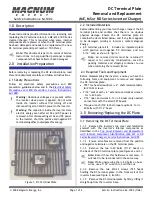
27
8 BATTERY CAPACITY AND PEUKERT EXPONENT
Battery capacity is expressed in Amp hour (Ah) and indicates how much current a battery can supply over time.
For example, if a 100Ah battery is being discharged with a constant current of 5A, the battery will be totally
discharged in 20 hours.
The rate at which a battery is being discharged is expressed as the C rating. The C rating indicates how many
hours a battery with a given capacity will last. 1C is the 1h rate and means that the discharge current will
discharge the entire battery in 1 hour. For a battery with a capacity of 100Ah, this equates to a discharge current
of 100A. A 5C rate for this battery would be 500A for 12 minutes (1/5 hours), and a C5 rate would be 20A for 5
hours.
The capacity of a battery depends on the rate of discharge. The faster the rate of discharge, the less capacity will
be available. The relation between slow or fast discharge can be calculated by Peukert’s law and is expressed by
the Peukert exponent. Some battery chemistries suffer more from this phenomenon than others. Lead acid are
more affected by this than lithium batteries are. The SmartShunt takes this phenomenon into account with
Peukert exponent.
Discharge rate example
A lead acid battery is rated at 100Ah at C20, this means that this battery can deliver a total current of 100A over
20 hours at a rate of 5A per hour. C20 = 100Ah (5 x 20 = 100).
When the same 100Ah battery is discharged completely in two hours, its capacity is greatly reduced. Because of
the higher rate of discharge, it may only give C2 = 56Ah.
Peukert’s formula
The value which can be adjusted in Peukert’s formula is the exponent n: see the formula below.
In the SmartShunt the Peukert exponent can be adjusted from 1.00 to 1.50. The higher the Peukert exponent the
faster the effective capacity ‘shrinks’ with increasing discharge rate. An ideal (theoretical) battery has a Peukert
exponent of 1.00 and has a fixed capacity regardless of the size of the discharge current. The default setting in
the SmartShunt for the Peukert exponent is 1.25. This is an acceptable average value for most lead acid
batteries.
Peukert’s equation is stated below:
𝐶𝐶𝐶𝐶
=
𝐼𝐼
𝑛𝑛
×
𝑡𝑡
where Peukert’s exponent n is:
𝑛𝑛
=
log
𝑡𝑡
2
−
log
𝑡𝑡
1
log
𝐼𝐼
1
−
log
𝐼𝐼
2
To calculate the Peukert exponent you will need two rated battery capacities. This is usually the 20h discharge
rate and the 5h rate, but can also be the 10h and 5h, or the 20h and the 10h rate. Ideally use a low discharge
rating together with a substantially higher rating. Battery capacity ratings can be found in the battery datasheet. If
in doubt contact your battery supplier.
Calculation example using the 5h and the 20h rating
The C5 rating is 75Ah. The t
1
rating is 5h and I
1
is calculated:
𝐼𝐼
1
=
75𝐴𝐴ℎ
5ℎ
= 25
𝐴𝐴
The C20 rating is 100Ah. The t
2
rating is 20h and I
2
is calculated:
𝐼𝐼
2
=
100𝐴𝐴ℎ
20ℎ
= 5
𝐴𝐴
The Peukert exponent is:
𝑛𝑛
=
log 20
−
log 5
log 15
−
log 5
= 1.26
A Peukert calculator is available at
http://www.victronenergy.com/support-and-downloadssoftware/
Please note that the Peukert exponent is no more than a rough
approximation of reality, and that at very high currents, batteries will give
even less capacity than predicted from a fixed exponent. We recommend
not to change the default value in the SmartShunt, except in case of lithium
batteries.
Содержание SmartShunt 1000A
Страница 1: ...EN Manual SmartShunt 500A 1000A 2000A...











































